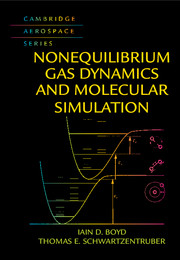Book contents
- Frontmatter
- Contents
- List of Illustrations
- List of Tables
- Preface
- Acknowledgments
- Part I Theory
- Part II Numerical Simulation
- 5 Relations Between Molecular and Continuum Gas Dynamics
- 6 Direct Simulation Monte Carlo
- 7 Models for Nonequilibrium Thermochemistry
- Appendix A Generating Particle Properties
- Appendix B Collisional Quantities
- Appendix C Determining Post-Collision Velocities
- Appendix D Macroscopic Properties
- Appendix E Common Integrals
- References
- Index
6 - Direct Simulation Monte Carlo
from Part II - Numerical Simulation
Published online by Cambridge University Press: 13 April 2017
- Frontmatter
- Contents
- List of Illustrations
- List of Tables
- Preface
- Acknowledgments
- Part I Theory
- Part II Numerical Simulation
- 5 Relations Between Molecular and Continuum Gas Dynamics
- 6 Direct Simulation Monte Carlo
- 7 Models for Nonequilibrium Thermochemistry
- Appendix A Generating Particle Properties
- Appendix B Collisional Quantities
- Appendix C Determining Post-Collision Velocities
- Appendix D Macroscopic Properties
- Appendix E Common Integrals
- References
- Index
Summary
Introduction
The direct simulation Monte Carlo (DSMC) method was created by Graeme Bird, a professor of aeronautical engineering at the University of Sydney, Australia. The first publication, appearing in Physics of Fluids in 1963, demonstrated the DSMC method as an alternative to molecular dynamics (MD) for a hard-sphere gas (Bird 1963). Since that time, Bird has written two textbooks on the DSMC method (Bird 1994, 2013) and an entire field of research has emerged with hundreds of publications on the DSMC method and its application to scientific and engineering problems. The DSMC method has become a powerful and widespread technique for the simulation of nonequilibrium gases where the molecular nature of the gas must be accounted for.
To begin this chapter, it is important to identify the range of flow conditions and engineering applications for which the DSMC method is most appropriate. As described by Bird (1994), dilute gas conditions can be separated into various regimes through nondimensional quantities.
First, the transition between a dilute gas and a dense gas occurs when the size (d) of the molecules themselves (the extent of their interatomic forces) becomes comparable to the mean separation distance (δ) between molecules in the gas. As the molecular size becomes comparable to the molecular separation distance, the mean-free-path and mean-collision-time scales vanish. Indeed, the molecules in a condensed phase (a solid or liquid) are in a constant collisional state, experiencing continual forces due to neighboring molecules. Although the molecules in a dense gas may have nonzero meanfree- path and mean-collision-time scales, these scales begin to approach the Angstrom and femtosecond scales used in molecular dynamics simulations. Furthermore, in dense gases, multimolecule interactions are frequent and must be accounted for. In contrast, in a dilute gas, in which the mean molecular spacing is large compared to molecular size, collisions are predominately binary in nature. Such binary collisions occur over time scales that are much shorter than the mean collision time and can be thought to occur instantaneously. As described in Chapter 1, this leads to the ideal gas equation of state.
- Type
- Chapter
- Information
- Nonequilibrium Gas Dynamics and Molecular Simulation , pp. 183 - 251Publisher: Cambridge University PressPrint publication year: 2017



